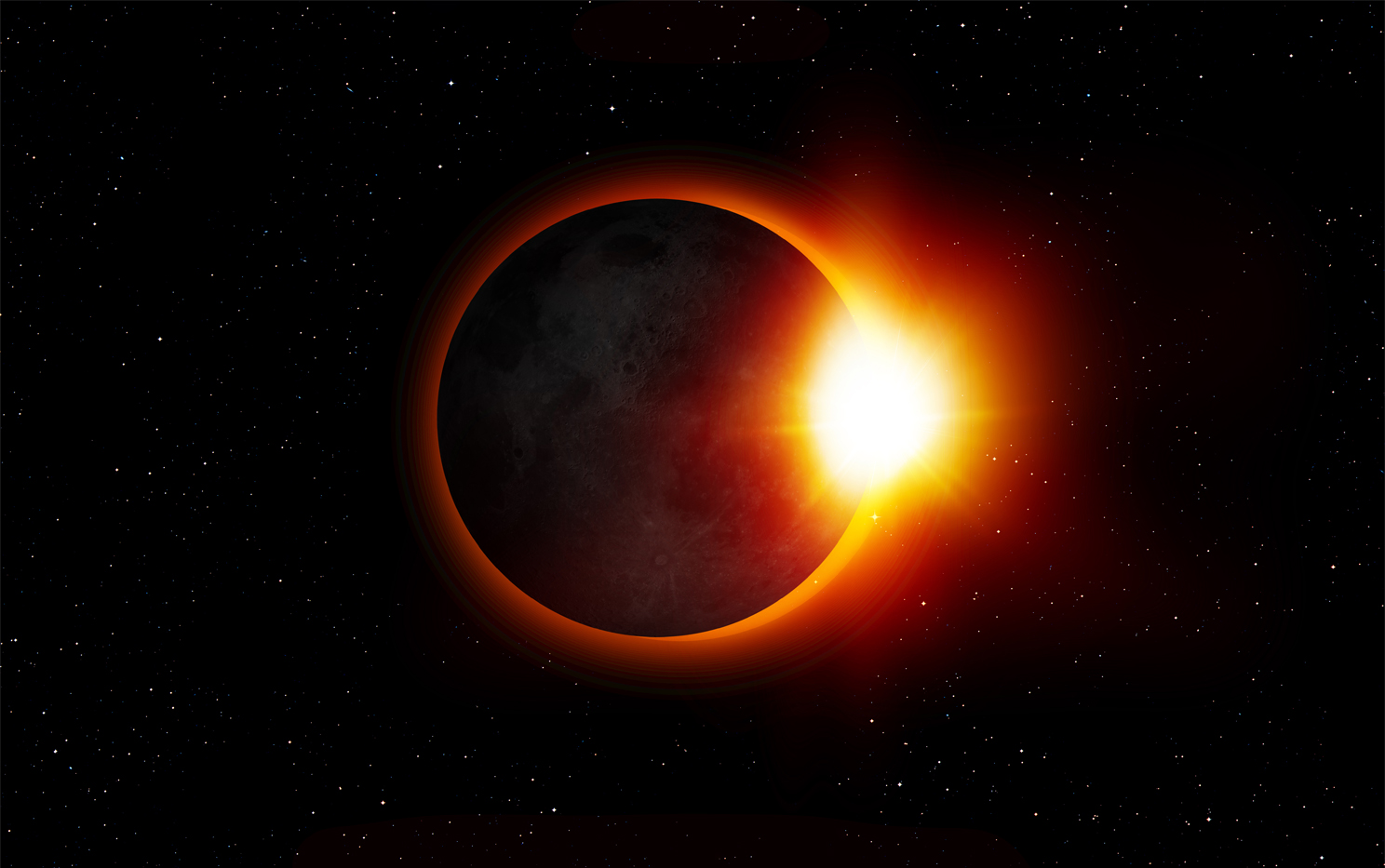On April 8, 2024, a total solar eclipse will be visible across North America. This rare astronomical event occurs when the Moon passes directly between the Earth and the Sun, blocking out the Sun’s light and creating a shadow on the Earth’s surface.
The path of totality for the 2024 eclipse starts in Mexico, crosses through the central United States from Texas to Maine, and ends in Atlantic Canada. Along this narrow path, the Moon will completely cover the disk of the Sun for over 4 minutes. Outside the path, a partial eclipse will be visible across most of North and Central America and parts of South America, Europe, and Africa.
Solar eclipses have fascinated people since ancient times. Eclipses were often interpreted as omens, and associated with the divine by many ancient cultures. In the modern era, total solar eclipses create excitement due to their rarity and offer opportunities for scientific research. The last total solar eclipse visible from the continental United States was in 2017, while the last comparable eclipse to pass over North America occurred in 1979.
The 2024 total solar eclipse will be the first total eclipse visible from Mexico City since 1991. It will be one of the most viewed eclipses in human history, with millions traveling to witness totality. The eclipse comes during a period of excellent eclipse visibility for North America, with another total eclipse occurring just seven years later in 2031.
What is a Solar Eclipse?
A solar eclipse occurs when the Moon passes directly between the Sun and the Earth, blocking out the Sun’s light and casting a shadow on the Earth. This happens when the Moon is new, meaning the side facing the Earth is not illuminated by the Sun. As the Moon orbits the Earth every month, its orbital plane intersects the Earth’s orbital plane around the Sun at certain points called nodes. When the Moon is positioned at a node point at the same time it’s new, the Moon will block the Sun from the perspective of locations on Earth within the Moon’s umbral shadow. This creates the solar eclipse.
The Moon’s shadow that falls on the Earth during an eclipse consists of two parts – the umbra and penumbra. The inner and darker umbra is where the Sun is completely blocked, creating a total eclipse. The outer penumbra is where the Sun is only partially obscured, resulting in a partial eclipse. The relatively small region where the umbra touches down is called the path of totality, and this is the only place that will experience a full total eclipse.
For a total solar eclipse to take place, the Sun, Moon, and Earth must be precisely aligned. This rare alignment allows the Moon to completely cover the Sun for a few brief minutes and reveal the Sun’s upper atmosphere, called the corona, which is usually obscured by the Sun’s bright face. This ethereal glowing corona and the fleeting darkness add to the unique beauty and awe of total solar eclipses.
The Path of Totality
The path of totality for the 2024 solar eclipse will span across North America from Mexico to Maine and parts of eastern Canada. The moon’s shadow will touch down on the west coast of Mexico beginning in the state of Sinaloa in the early morning. It will then travel northeast through parts of Texas, including Austin, San Antonio, and Dallas-Fort Worth.
The path continues diagonally cutting through Oklahoma, Arkansas, Missouri, Illinois, Indiana, Kentucky, Tennessee, Michigan, New York, Vermont, New Hampshire and Maine. Some of the major cities in the path include Oklahoma City, Indianapolis, Cincinnati, Cleveland, Buffalo, Rochester, Burlington, Montpelier, and Bangor.
The path of totality will also cross over Lake Michigan, Lake Erie, Lake Ontario and parts of eastern Canada including Montreal and southern Quebec. The maximum duration of totality will occur near the town of Nazas, Mexico and will last for 4 minutes and 28 seconds. The eclipse ends just after entering Newfoundland in Canada.
Overall the path spans about 125 miles wide and over 4,000 miles long, providing around 50 million Americans the chance to experience a total solar eclipse right in their backyard. This will make the 2024 eclipse the most viewed total solar eclipse in history. The unique path over populated areas will allow millions to witness the awe-inspiring sights and fascinating science of a total solar eclipse.
Viewing the 2024 Eclipse
The 2024 total solar eclipse will be visible across North America on April 8, 2024. This rare astronomical event provides a unique opportunity to witness a total solar eclipse if you are located along the path of totality. However, viewing the sun directly can cause permanent eye damage if proper precautions are not taken. Here are some tips for safely viewing the 2024 total solar eclipse:
Eye Protection
Special eclipse glasses or handheld solar viewers should be used at all times when viewing the eclipse, except for the brief period of totality. These allow you to look directly at the sun and block out harmful ultraviolet and infrared radiation. Regular sunglasses are not safe for direct solar viewing.
Eclipse glasses can be purchased online or from science museums and astronomy retailers. Be sure they are ISO certified and meet the ISO 12312-2 international safety standard. Inspect eclipse glasses for damage before use.
Welder’s glass #14 or greater can also be used to view the sun. Do not use exposed filters; always place the filter in front of eyes.
Telescopes and Binoculars
Do NOT use regular telescopes or binoculars to view the eclipse, as they concentrate the solar rays and can burn your eyes.
Solar filters must be placed over the front aperture of any telescope or binocular before use. Be sure to purchase filters specifically designed for solar viewing.
Pinhole Projectors
Pinhole projectors offer a safe, indirect viewing method by projecting the image of the eclipsed sun onto another surface.
Poke a small round hole in one side of a cereal box, and project the sun’s image through the hole onto the inside of the opposite side of the box.
Never look through the pinhole at the sun. Stand with your back to the sun and allow the projected image to fall on the inside of the box.
Photography
Special solar filters are required over camera lenses and should be professionally manufactured, not homemade. Partial solar filters are unsafe.
Carefully inspect filters for defects like scratches or holes. Attach snugly to the front of lenses. Check camera settings and focus before starting.
Use a sturdy tripod, cable release and bracketing to take multiple exposures. Practice beforehand.
Eye Safety
Never view the sun through unfiltered cameras, telescopes, binoculars or with your naked eye, except for the brief period of totality when the moon completely covers the sun’s surface. Serious eye damage can result very quickly from looking at the sun.
Watch children at all times to keep them from peeking without filters. Seek expert guidance if you have any questions.
Be prepared by having proper eye protection ready before the start of the eclipse. As totality approaches, be sure to put it on and take it off at the correct times to safely view the partial and total phases.
Cities and Locations in the Path
The path of totality for the 2024 solar eclipse passes through several major cities in North America, making it easily accessible for millions of people. Here are some of the notable cities and locations where the total eclipse will be visible:
Dallas-Fort Worth, Texas
The Dallas-Fort Worth metroplex in northeast Texas lies directly in the path of totality. Over 7 million residents will be able to step outside on eclipse day and view the total solar eclipse from their hometown.
Austin, Texas
The capital of Texas also falls along the centerline and will witness the full solar eclipse. Known for its vibrant music scene and tech industry, Austin draws over 30 million visitors per year. The eclipse will be a major attraction in 2024.
Indianapolis, Indiana
Indianapolis, the capital of Indiana, will experience 2 minutes and 20 seconds of totality during the eclipse. Located in the Midwest, it will be one of the most populous cities to see the total eclipse.
Cleveland, Ohio
Located along Lake Erie in northeast Ohio, metro Cleveland will have front-row seats to the eclipse. It’s among the largest US cities in the path with over 2 million residents in the area.
Buffalo, New York
Buffalo, in western New York, lies directly beneath the path of totality. It offers a more northeastern viewing location compared to other cities. Buffalo’s long eclipse duration of 2 minutes and 20 seconds will provide ample time for viewing.
Mexico City, Mexico
Mexico’s capital and largest city will witness a short total eclipse phase. Located at high elevation, Mexico City provides a unique vantage point. Millions of residents will experience the eclipse over this iconic metropolis.
Montreal, Quebec, Canada
Montreal will be the largest Canadian city in the path of totality. Occurring during summer, the eclipse will captivate residents and draw many visitors to eastern Canada. Montreal’s vibrant culture and natural scenery provide ideal settings for eclipse events and viewing.
Schedule and Timing
The 2024 total solar eclipse will occur on Monday, April 8, 2024. This is when the path of totality will sweep across North America.
The partial eclipse will begin at sunrise on the U.S. East Coast, and the total eclipse will end at sunset on the West Coast. The total eclipse will last up to 4 minutes and 28 seconds, with the longest duration of totality occurring southwest of Dallas, Texas.
The path of totality will first make landfall on Mexico’s Yucatán Peninsula around 12:50 p.m. CDT, then move northeast across Texas, Oklahoma, Arkansas, Missouri, Illinois, Kentucky, Indiana, Ohio, Pennsylvania, New York, Vermont, New Hampshire, and Maine, before exiting the U.S. around 2:50 p.m. EDT near Eastport, Maine.
The first location in the continental U.S. to see totality will be Texas at 1:00 p.m. CDT, with the eclipse reaching maximum totality over Carbondale, Illinois at 1:22 p.m. CDT. The eclipse will exit the country over northern Maine around 2:35 p.m. EDT.
Specific start and end times for totality will vary for locations along the path, but the eclipse will provide up to nearly 4.5 minutes of totality in certain areas. Planning ahead for precise viewing times based on geographic location will be important to catch the full eclipse.
Scientific Importance
Solar eclipses provide a rare opportunity for scientists to make observations that aren’t possible under normal circumstances. The brief period of totality offers a chance to study the solar corona and chromosphere in ways that can’t be replicated artificially.
Some key scientific benefits of solar eclipses include:
Observing the sun’s corona. The corona is usually obscured by the brightness of the sun’s photosphere. But during totality, the moon blocks the photosphere, revealing the corona’s intricate structures. Studying the shape and activity of the corona provides insights about the sun’s magnetic field.
Measuring the temperature of the corona. The corona can reach temperatures over 1 million kelvin, while the photosphere is only about 5,800 K. Understanding these temperature differences can reveal new information about how energy moves through the sun’s atmosphere.
Seeing stars and planets near the sun. Stars located very close to the sun are normally obscured by the sun’s brightness. But they become visible during an eclipse, allowing measurements of their properties.
Studying the sun’s chemical composition. Spectroscopic observations can be made of the solar chromosphere to learn more about the types and amounts of elements present.
Testing theories of relativity. Eclipses provide opportunities to verify predictions made by Einstein’s theory of general relativity, such as the bending of light around the sun.
Learning more about the solar wind. Changes in the corona allow researchers to study how the solar wind originates and is accelerated outward from the sun’s atmosphere.
The rare conditions created by total solar eclipses open doors for new discoveries about the sun and astronomical phenomena that influence life on Earth. Each eclipse provides a valuable chance to push the boundaries of solar science and physics.
Social Impact and Tourism
The 2024 solar eclipse is expected to draw huge crowds into the path of totality as people travel to experience the rare phenomenon. Some estimates predict that 10 million people or more will flock to the eclipse path stretching from Mexico to Maine and through parts of Canada.
Towns and cities along the path are already preparing for the influx of visitors who will fill hotels, pack highways, and likely cause traffic congestion and strain on infrastructure. Local officials are working with scientists and tourism boards to plan activities, viewing events, educational programs, and ways to accommodate the crowds.
Some areas are better equipped for large numbers of tourists while smaller towns may become overwhelmed. There are concerns about having adequate bathroom facilities, medical personnel, cell tower capacity, and emergency plans in place.
While the eclipse will only last a few minutes in each location, people are expected to arrive several days in advance and linger afterwards. This will bring economic benefits to businesses and boost local economies, especially in more remote areas. But it also requires planning to ensure public safety and manage environmental impact.
Officials want to encourage tourism and enthusiasm for the eclipse while also informing visitors how to enjoy the event responsibly. With proper preparation, communities can reap rewards while protecting local resources. The 2024 total solar eclipse will showcase natural wonder as well as humanity’s shared desire to experience cosmic events.
Past Total Solar Eclipses
Total solar eclipses are rare astronomical events that occur when the moon passes directly between the sun and the Earth, completely blocking the sun’s light for a few precious minutes. Though eclipses of the sun occur frequently, total solar eclipses are only visible from a narrow path on the Earth’s surface, and the same location only experiences a total solar eclipse about once every 375 years.
Some of the most significant total solar eclipses in history include:
May 28, 585 BCE – The earliest recorded solar eclipse in history, mentioned in the writings of the ancient Greek poet Archilochus. It occurred during a battle between the Medes and Lydians, who interpreted the sudden darkness as an omen and called a truce.
August 21, 2017 CE – Dubbed the “Great American Eclipse”, this eclipse was visible across the entire continental United States for the first time in 99 years. It generated immense public interest and was the most widely viewed and photographed eclipse in history. Over 200 million people watched from within the path of totality.
June 8, 1918 CE – This eclipse passed over the U.S. and was visible from San Diego to Florida. It was one of Albert Einstein’s tests of his general theory of relativity, which predicted that gravity would bend light from stars. Observations taken during the eclipse proved Einstein’s theory correct.
July 11, 1991 CE – The longest total eclipse of the 20th century, lasting over 6 minutes. It traversed Hawaii, Mexico and Central America, with the path of totality passing over extremely populated regions, treating millions to an extraordinary cosmic display.
August 18, 1868 CE – This eclipse track arced from Alaska to North Carolina, passing directly over Denver, Colorado. It was the first solar eclipse ever photographed, producing the earliest known eclipse images.
May 29, 1919 CE – Provided experimental evidence supporting Einstein’s general theory of relativity. Photographs of stars near the sun taken during the eclipse showed light bending, confirming Einstein’s predictions. Made Einstein an overnight celebrity.
Total solar eclipses have captivated people for millennia and led to many important scientific discoveries that expanded our understanding of the universe. Each new total solar eclipse offers an opportunity to witness one of nature’s most magnificent spectacles.
Future Total Solar Eclipses
Upcoming total solar eclipses in the years after 2024 will crisscross the globe, creating amazing viewing opportunities for people willing to journey to the path of totality.
On August 2, 2027, a total solar eclipse will be visible from parts of Europe, the Middle East, and Northeast Africa. The path of totality will pass through Spain, Algeria, Tunisia, Libya, and Egypt. Some of the major cities that fall under the path are Seville, Cordoba, Algiers, and Alexandria.
Just two years later, on July 22, 2029, one of the longest total solar eclipses of the century will occur, with totality lasting over 6 minutes. The path will cut across North America from Texas through the Midwest and into Atlantic Canada. Major cities in the path include Austin, Cleveland, Toronto, and Montreal.
In 2034, the path of totality will stretch across North Africa and the Middle East on March 30. Cities like Rabat, Tripoli, and Damascus will experience total solar eclipse. On September 2, 2035 another eclipse will traverse China, Korea, and Japan.
Further into the future, additional total solar eclipses will occur in 2038, 2045, 2051, and 2057. Locations as diverse as Australia, India, Panama, and Greenland will fall under the path of totality. For eclipse chasers willing to travel, the next few decades will provide amazing opportunities to experience the breathtaking beauty of total solar eclipses.










